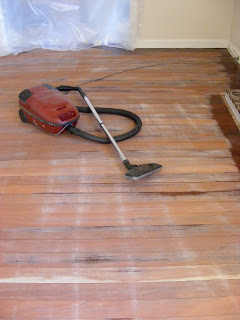The first pass leaves lot of white marks on the floor, where the old varnish is only half taken off. This is what the drum sander looks like. A big lawnmower type thing. It has a button to start it, and a handle for lowering the sandpaper inside to the floor. So you start it with the paper in the air, then lower it very carefully to the ground. Then the machine starts moving itself forwards, so you simply make sure you walk at an even pace, and lift the paper up again before you reach the skirting. It clears around a single floor board with each go. You can see the extra sandpaper rolls in the area we have yet to do here.
Also it's important to cover any open areas with plastic sheets so dust doesn't go all over the house. We also covered the grills of the fireplace and the air conditioner. The place looks like Mars when you're finished with everything covered in red dust.
It is important to hoover carefully after each pass of the sanding machine. This removes the piles of dust and lets you see what is really happening with the floor.
This picture above is after the second pass, with 80 grit paper. It isn't so rough with the floor, but smoothes out the surface a bit. Note still though there are lots of white bits and a few tiny bits of varnish left at the edges of the floorboards. Another pass is needed. Actually, I think we did 2 passes with each grit of paper. It is quite a large room so the paper was getting worn out.
This is the difference between the 80 grit and 120 grit passes. The second picture shows very few white marks. This means it is ready for washing and varnishing. But not at the edge. The belt sander can only reach to within a few inches from the wall, as the sandpaper turns around in the middle of the machine, not the very edge.
This is how close it gets. See there is a foorprint worth of old varnish left. We used an edge sander to clear this up. I got no pictures of it though, so I'll get that when we sand the spare bedroom, which should be pretty soon now!






No comments:
Post a Comment